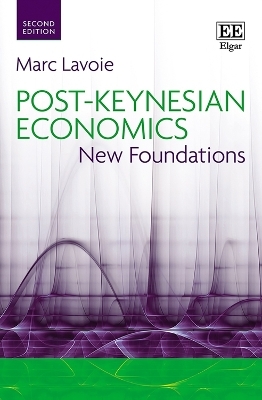
The American Monetary System
Springer International Publishing (Verlag)
978-3-319-37951-7 (ISBN)
Today's financial system is considerably more complex than in years past, as new financial instruments have been introduced that are not well understood even by the people and institutions that invest in them. Numerous high-risk opportunities are available, and the number of people who unwittingly wander into such ventures seems to grow daily. There is also the realization that people's lives are affected by the financial system without their overt participation in it. Despite no active participation, pensions can be emasculated by a sudden decline in interest rates, or a rise in rates can increase the monthly payments on a mortgage, credit cards or other debt. This book looks at the history of the American banking system, including the passage of the Federal Reserve Act in 1913, the implementation of deposit insurance, along with certain other provisions of the Glass-Steagall Act of 1933, the Bretton-Woods agreements, the forces of technological innovation and the Dodd-Frank Act, passed by Congress in 2010 for regulatory reform. This book will be of interest to undergraduate and graduate level students that want to gain a broad understanding of how the financial system works, why it is important to the economy as a whole, and what its strengths and weaknesses are. Also, readers should gain an understanding of what the Federal Reserve, other regulators and other central banks are doing, and will be in a position to critique their actions and say with some depth of understanding why they agree or disagree with them.
Introduction.- Part I.- Historical Perspectives on Money,Financial Institutions and Markets.- What Gives Money Its Value? -- From Goldto Paper.- What is Driving the Financial World Today?.- Part II Banking: Asset& Liability Management; Banking Supervision & Regulation.- How AreBanks Funded?.- How Do Banks Use Their Funds?.- Who Owns the Banks? BankCapital and the Basel Accord.- How Safe Are Our Banks?.- Part III FinancialMarkets and the Management of Financial Risk.- What Makes the System Work?.- WhoFinances American Industry? - The Relative Roles of Commercial and InvestmentBanking.- What Went Wrong and What Are We Doing to Fix It? -A Chronology ofFinancial Crises.- Why Have Financial Risks Skyrocketed, and How Is theIndustry Dealing With It?.- Part IV Central Banking and Monetary Policy.- WhatAre the Purposes and Functions of the Federal Reserve System? 248.- How isAmerican Monetary Policy Made, and How Does It Affect the Domestic and GlobalEconomies?.- About the Author.- Bibliography.
This book is a true tour de force - a readable, comprehensive description of the evolution of The American Monetary System since the founding of the nation. Very few would have the intellectual capacity, the talent, the training and the experience to put it all in perspective. But somehow Bill Wallace has done the job.
I worked with Bill closely when I was the Chairman of the Federal Reserve Board. Consequently, I was a principal beneficiary of his long experience, his well-balanced judgment, and his dedication to the Federal Reserve and its leadership.
His varied responsibilities over the decades at "the Fed" provided a superb vantage point from which he could observe and participate in rapid financial change, the associated turbulence, and the official response to all-too-frequent crises. What I was slow to recognize was his ability to write so clearly and simply, making this book not only a point of reference about the world of finance but a well-informed readable analysis of one important element of American economic and political life.
Bill Wallace was a model public servant, bringing his analytical skills together with a clear sense of the practical problems of monetary policy and financial regulation. He also loved to teach. It is the combination of those ingerests that make this book, with its subtitle of 'An Insider's View of Financial Institutions, Markets and Monetary Policy' so relevant today.
The book is not a blow-by-blow description of the latest and largest crisis. It does something more important. It puts today's problems in the context of inevitable change - change that has recurrent market characteristics even as it has features unique to a world of computers and the internet, of instantaneous communication, and of "synthetic" securities and"derivatives" instruments.
Quite simply, it is a volume that deserves space on your book shelf.
Paul Volcker
12/9/2013| Erscheinungsdatum | 19.08.2016 |
|---|---|
| Zusatzinfo | XXII, 228 p. 15 illus., 12 illus. in color. |
| Verlagsort | Cham |
| Sprache | englisch |
| Maße | 155 x 235 mm |
| Themenwelt | Wirtschaft ► Volkswirtschaftslehre ► Finanzwissenschaft |
| Wirtschaft ► Volkswirtschaftslehre ► Makroökonomie | |
| Wirtschaft ► Volkswirtschaftslehre ► Wirtschaftspolitik | |
| Schlagworte | Central Banking • Economics and finance • Economic Systems • Economic systems and structures • Financial Risk • Global Economies • Macroeconomics • Macroeconomics/Monetary Economics//Financial Econo • Monetary Economics • monetary policy • Public Economics • Public finance and taxation • US Financial Institutions |
| ISBN-10 | 3-319-37951-8 / 3319379518 |
| ISBN-13 | 978-3-319-37951-7 / 9783319379517 |
| Zustand | Neuware |
| Haben Sie eine Frage zum Produkt? |
aus dem Bereich


